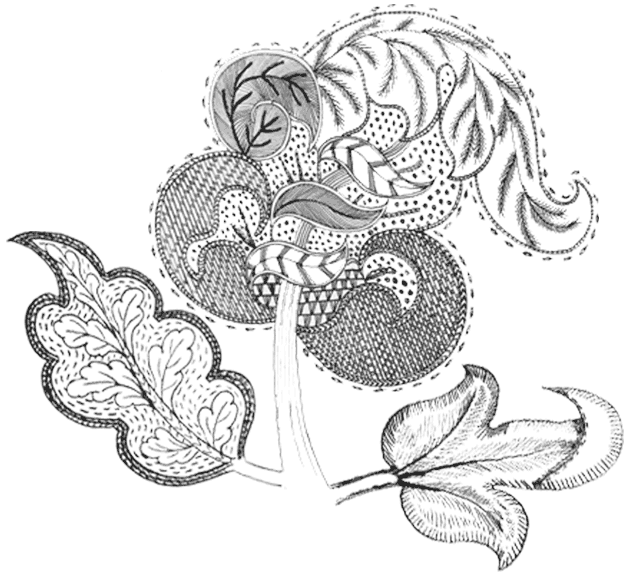This Jacobean embroidery design – great for crewel work (embroidery in wool) or any other kinds of threads – is kind of fun. If you look closely or enlarge, you’ll see that the image includes stitching patterns. Working up the variety of patterns of fillings and line stitches is as good as working on a sampler.
You could embroider a pillow cover or a nice wall accent… or just have fun learning the stitches to no determined end!
The elements of this design came from an old, old book I have – way out print, no copyright info available in it. I took a couple different parts of different scanned images and put them together to see how they would look. I wanted to try a whole variety of stitches in the form of a kind of sampler just to get familiar with Jacobean work, and this looked like a neat way to do it.
I think that traditionally, Jacobean work wasn’t necessarily done in wool. Considering the time period (Elizabethan and a little later), it seems more likely that real Jacobean embroidery would have been stitched on linen or even finer cloth, and probably with silk threads. The motifs in Jacobean work, after all, were seen on the clothing (vests, jackets, etc.) of the nobility. Typical motifs were stylized plant life and vines, animals, flowers, bugs. There is a distinct similarity between Jacobean motifs and the illuminated work produced during the same era, with its funky strange animals, flowers, bugs, bees, gargoyles, etc.
If you want to play with this design, click on it for a larger image, then right click and save it to your computer. You can resize it on a photocopier or on your computer. If the image isn’t quite clear enough, you can always touch it up and retrace it – and, if you’re feeling creative – you can add a few personal touches, such as more leaves, a berry stem, or whatnot.








Yeah, yeah, just me.
So’s you know – ‘gargoyles’ are monsters on buildings. (you mention them above as being in Jacobean designs)
“grotesques” are monsters in paintings/illuminated pages. And, I imagine, Jacobean designs.
Gotta keep our monsters straight!
“Images on The Edge” by Michale Camille is a fascinating book talking about what monkeys farting etc actually *meant* – the artists were making comments that would be completely unacceptable by the Church today!
🙂
Actually, the term “gargoyle” means gargler, and it refers to the function of these embellishments, which is to serve as a downspout for rainwater runoff. These figures weren’t meant to be seen as monsters, but amusing fantasy figures. Sometimes the “olden days” were more sophisticated than we think.
Mary, I want to thank you for the time and trouble you take to share your talent with those of us that aspire to achieve ‘taking our embroidery up a level or two.
Is there any way I can see this sample already worked up? I’m just learning and don’t know all the stitches yet, and it’s easier for me if I can see a finished product, over just the black and white. Just how my brain works. ^_^
Love your articles. Thanks so much for sharing.
No, the patterns offered for free here on Needle ‘n Thread are simply patterns. The rest is up to you!
Do you have crewel bell pull kits . Thank you Cecilia